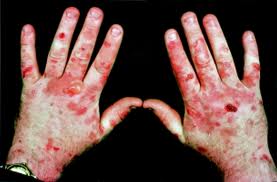Disorders
- Anorexia Nervosa
- Binge Eating Disorder
- Bitot's Spots
- Bulimia Nervosa
- Macrocytic Anemia
- Megaloblastic Anemia
- Night Blindness
- Peptic Ulcer
- Prophylaxis
- Rhodopsin
- Rickets Disease
- Scurvy Disease
- Wilson’s Disease
- Xerophthalmia
- Hemochromatosis
- Siderosis
- Thalassemia
- Sideroblastic Anemia
- Porphyria Cutanea Tarda
- Sickle Cell Anemia
- Kwashiorkor
- Menkes Disease
- Neutropenia
- Keratomalacia
- Beriberi
- Pellagra
- Macrocytic
- Megaloblastic
- Pernicious Anemia
- Scurvy
- Rickets
- Osteomalacia
- Abetalipoproteinemia
- Muscular Dystrophy
- Haemolytic Anaemia
- Cholestatic Constipation
- Pretibial Myxedema
- Cretinism Diesease
- Hypothyroidism
- Hypothyroidism
- Feline Hyperthyroidism
- Graves Disease
- Plummer’s Disease
- Thyrotoxicosis
- Acrodermatitis Enteropathica
- Congenital Hypothyroidism
- Hashimoto’s Thyroiditis
- Hyperthyroidism
- Keshan Disease
- Lose Weight with Hypothyroidism
- Metal Fume Fever
- Postpartum Thyroiditis
- Thyroid Storm
- Subclinical Hypothyroidism
Highlighting Porphyria Cutanea Tarda Picture

Everyone wants smooth, clean skin, free of blemishes, and other skin disorders. Unfortunately, this is often not the case; and many individuals are born with or develop some type of skin aliment over their lifetime. The key thing to remember is not to take any unnecessary chances, and if you develop a skin growth, rash or blemishes of any kind, have they checked out by a doctor or dermatologist.
Porphyria Cutanea Tarda is a common type of porphyria. Porphyria is characterized as a group of different disorders caused by abnormalities in the chemical steps leading to the production of heme, a substance that is a key element to the human body. Individuals with this skin aliment develop sores, blisters, and cysts on areas of the skin that are most exposed to the sun. Some individuals develop brown patches around the eyes and an increase in facial hair. In some cases, the skin can become hard.
Who can get them?
Anyone can develop Porphyria Cutanea Tarda. It can affect all r aches, and all sexes equally. Young and middle-aged adults seem to be more affected with this skin aliment.
What can cause them?
The primary cause of Porphyria Cutanea Tarda is due to a defective enzyme in the liver. This enzyme is responsible for the synthesis of the red pigmentation in the blood cells. There is some evidence that suggests that genetics can play a role in the development of Porphyria Cutanea Tarda.
How does it happen?
Porphyria Cutanea Tarda results from low levels of the enzyme that helps with the synthesis of blood production. This causes an increase in porphyrins in the skin, making it more sensitive to sunlight. The areas of the skin that are exposed become damaged and can develop blisters, rashes and changes in the coloring of the skin.
Where do they appear?
Porphyria Cutanea Tarda often appears on areas of the skin that are exposed to the sun. These include the hands, forearms, neck, face, and chest area.
What are the symptoms?
Individual inflicted with Porphyria Cutanea Tarda develop blisters on the areas of the skin that has been exposed to the sun. They may notice that they get sun burned easily. Brown patches may develop around the eyes, and an increase of facial hair may also be present. Crusting and scarring of the area can also occur and it does take time for the skin disorder to heal. The skin under these conditions is also very susceptible to trauma and needs to be protected.
How can it be diagnosed?
Porphyria Cutanea Tarda can be diagnosed by testing the individual’s blood plasma, urine and stool for porphyrins. If an individual has high levels of porphyrins present, this is a positive indication that you could have Porphyria Cutanea Tarda. A skin biopsy can also be done to confirm this skin disorder.
What treatments are available?
Treatment of Porphyria Cutanea Tarda is a unique one, but one that can yield positive results. The primary treatment is phlebotomy. This is where a pint of blood is taken from an individual; this would have to be done every one to two weeks. This procedure reduces the amount of iron that is in the person’s system, and since iron plays a role in the enzyme production this helps, once the levels of porphyrin in the liver and plasma are reduced the skin starts to become normal again. This will usually have to done approximately five or six times.
The individual will also have to avoid alcohol and iron. You have to wear an opaque type sun-block when you go outside, this will help to reduce the blisters that form. In some cases, some type of anti-malarial tablets will be recommended, but this is only used in extreme cases.
In some cases, the development of a skin disorder is a result of something not functioning correctly in the body. Porphyria Cutanea Tarda is one such type of skin disorder. It is a consequence of having a defective enzyme in the liver. It is important that if you develop this skin aliment to contact your doctor, you may need to see a specialist who deals with blood and liver disorder; in order to get the proper treatment.
